Causes, Effects, and Solutions of Famine
VerifiedAdded on 2022/12/15
|8
|2013
|198
AI Summary
This essay explores the causes, effects, and solutions of famine. It discusses the impact of war, crop failure, and government policies on famine, and highlights the need for prevention and mitigation strategies. The essay also mentions specific countries affected by famine, such as South Sudan, Nigeria, Somalia, and Yemen.
Contribute Materials
Your contribution can guide someone’s learning journey. Share your
documents today.
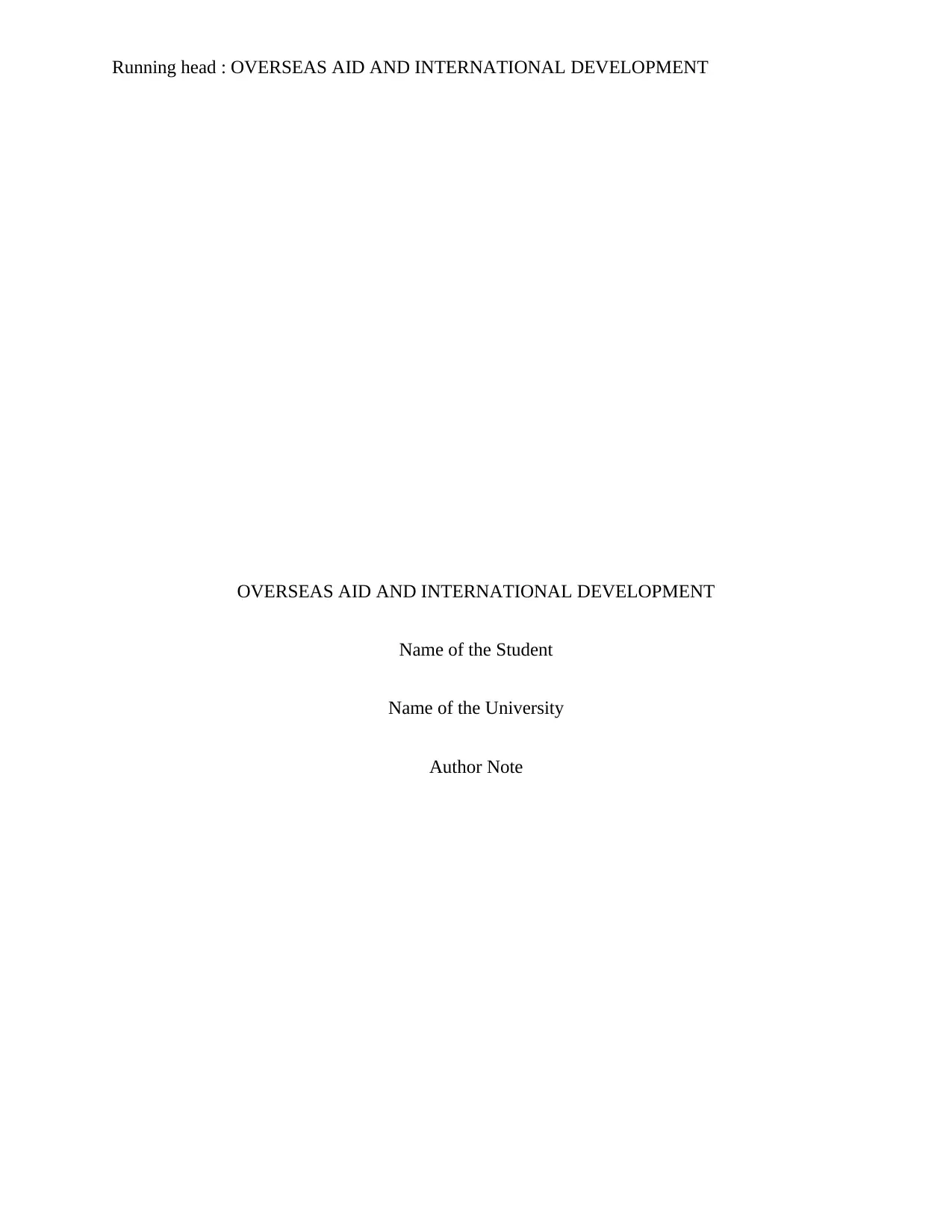
Running head : OVERSEAS AID AND INTERNATIONAL DEVELOPMENT
OVERSEAS AID AND INTERNATIONAL DEVELOPMENT
Name of the Student
Name of the University
Author Note
OVERSEAS AID AND INTERNATIONAL DEVELOPMENT
Name of the Student
Name of the University
Author Note
Secure Best Marks with AI Grader
Need help grading? Try our AI Grader for instant feedback on your assignments.
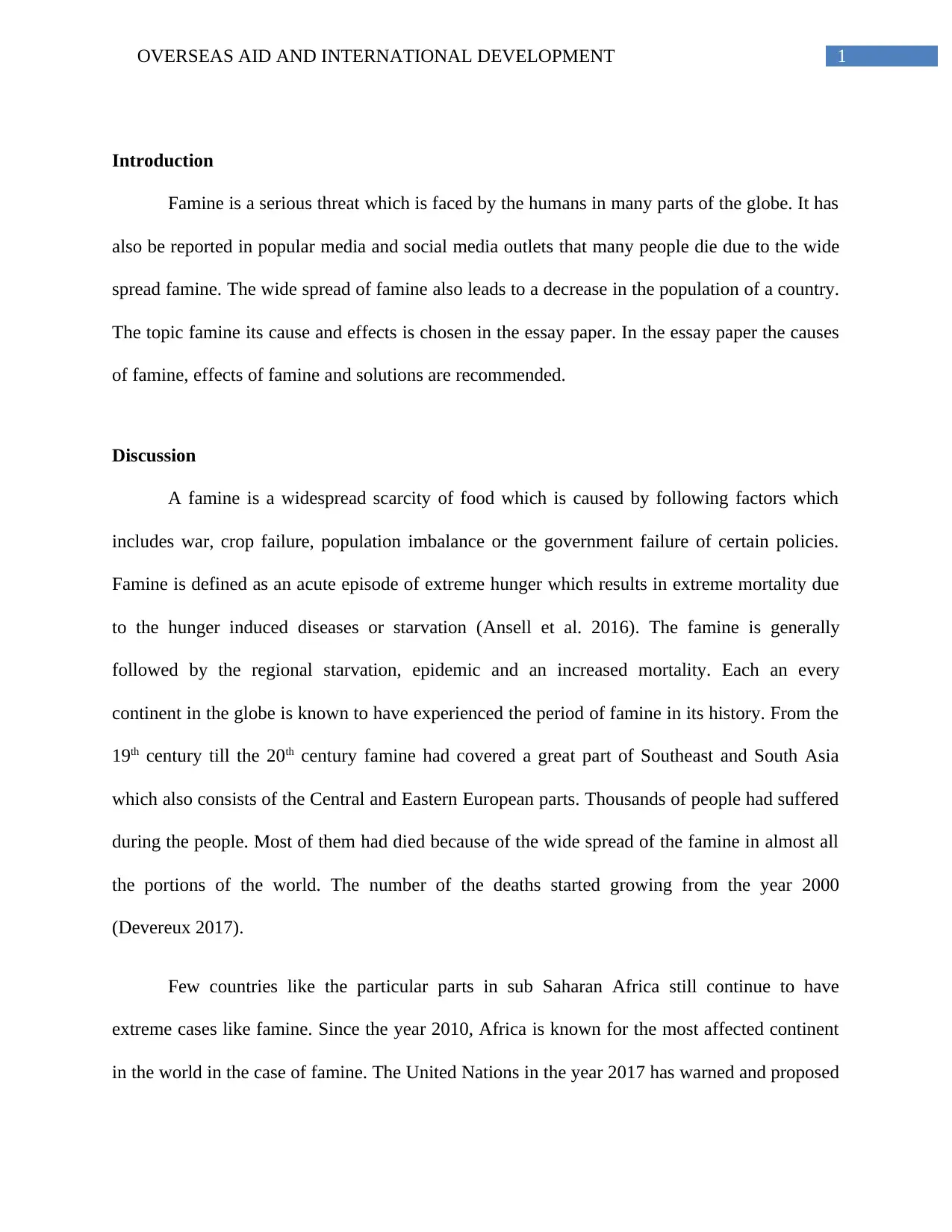
1OVERSEAS AID AND INTERNATIONAL DEVELOPMENT
Introduction
Famine is a serious threat which is faced by the humans in many parts of the globe. It has
also be reported in popular media and social media outlets that many people die due to the wide
spread famine. The wide spread of famine also leads to a decrease in the population of a country.
The topic famine its cause and effects is chosen in the essay paper. In the essay paper the causes
of famine, effects of famine and solutions are recommended.
Discussion
A famine is a widespread scarcity of food which is caused by following factors which
includes war, crop failure, population imbalance or the government failure of certain policies.
Famine is defined as an acute episode of extreme hunger which results in extreme mortality due
to the hunger induced diseases or starvation (Ansell et al. 2016). The famine is generally
followed by the regional starvation, epidemic and an increased mortality. Each an every
continent in the globe is known to have experienced the period of famine in its history. From the
19th century till the 20th century famine had covered a great part of Southeast and South Asia
which also consists of the Central and Eastern European parts. Thousands of people had suffered
during the people. Most of them had died because of the wide spread of the famine in almost all
the portions of the world. The number of the deaths started growing from the year 2000
(Devereux 2017).
Few countries like the particular parts in sub Saharan Africa still continue to have
extreme cases like famine. Since the year 2010, Africa is known for the most affected continent
in the world in the case of famine. The United Nations in the year 2017 has warned and proposed
Introduction
Famine is a serious threat which is faced by the humans in many parts of the globe. It has
also be reported in popular media and social media outlets that many people die due to the wide
spread famine. The wide spread of famine also leads to a decrease in the population of a country.
The topic famine its cause and effects is chosen in the essay paper. In the essay paper the causes
of famine, effects of famine and solutions are recommended.
Discussion
A famine is a widespread scarcity of food which is caused by following factors which
includes war, crop failure, population imbalance or the government failure of certain policies.
Famine is defined as an acute episode of extreme hunger which results in extreme mortality due
to the hunger induced diseases or starvation (Ansell et al. 2016). The famine is generally
followed by the regional starvation, epidemic and an increased mortality. Each an every
continent in the globe is known to have experienced the period of famine in its history. From the
19th century till the 20th century famine had covered a great part of Southeast and South Asia
which also consists of the Central and Eastern European parts. Thousands of people had suffered
during the people. Most of them had died because of the wide spread of the famine in almost all
the portions of the world. The number of the deaths started growing from the year 2000
(Devereux 2017).
Few countries like the particular parts in sub Saharan Africa still continue to have
extreme cases like famine. Since the year 2010, Africa is known for the most affected continent
in the world in the case of famine. The United Nations in the year 2017 has warned and proposed
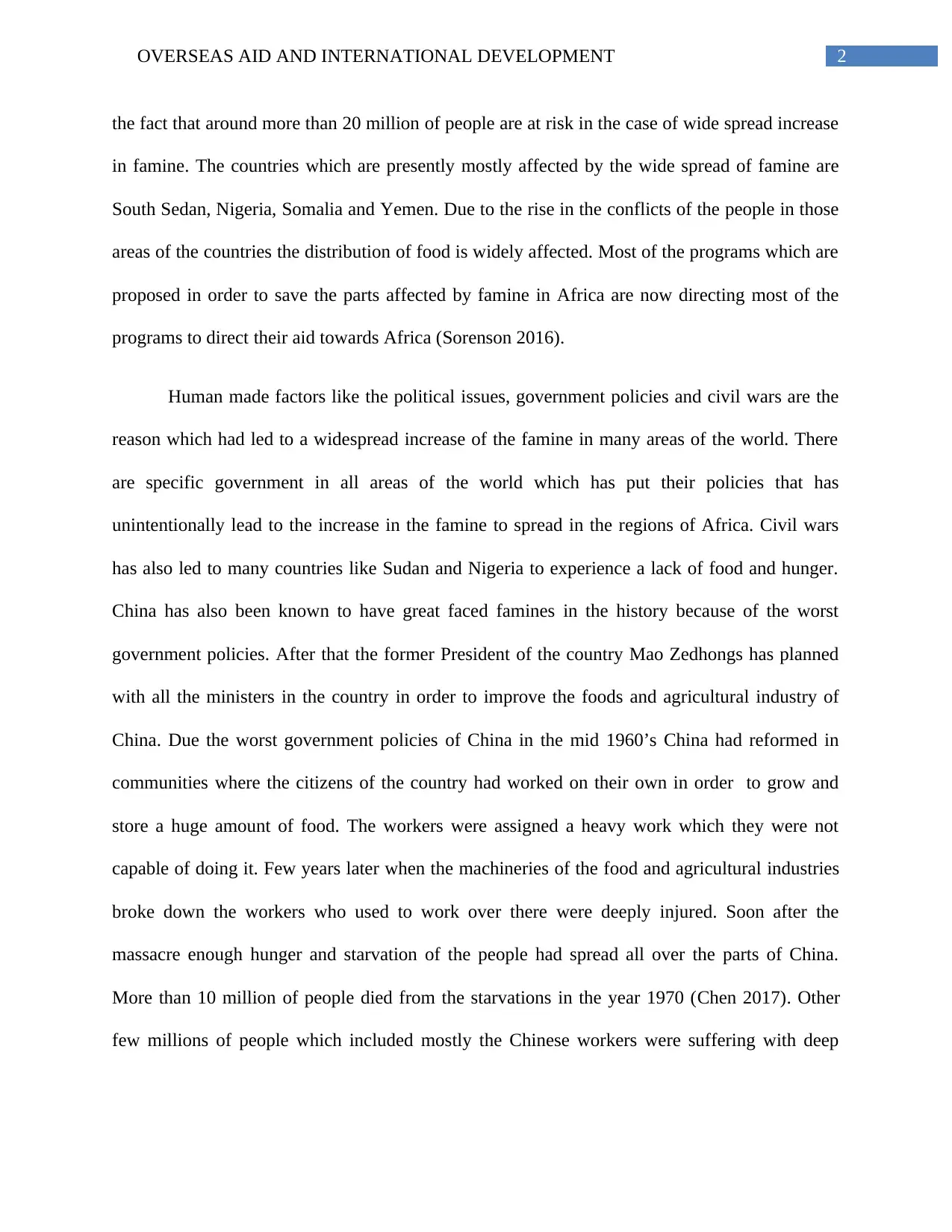
2OVERSEAS AID AND INTERNATIONAL DEVELOPMENT
the fact that around more than 20 million of people are at risk in the case of wide spread increase
in famine. The countries which are presently mostly affected by the wide spread of famine are
South Sedan, Nigeria, Somalia and Yemen. Due to the rise in the conflicts of the people in those
areas of the countries the distribution of food is widely affected. Most of the programs which are
proposed in order to save the parts affected by famine in Africa are now directing most of the
programs to direct their aid towards Africa (Sorenson 2016).
Human made factors like the political issues, government policies and civil wars are the
reason which had led to a widespread increase of the famine in many areas of the world. There
are specific government in all areas of the world which has put their policies that has
unintentionally lead to the increase in the famine to spread in the regions of Africa. Civil wars
has also led to many countries like Sudan and Nigeria to experience a lack of food and hunger.
China has also been known to have great faced famines in the history because of the worst
government policies. After that the former President of the country Mao Zedhongs has planned
with all the ministers in the country in order to improve the foods and agricultural industry of
China. Due the worst government policies of China in the mid 1960’s China had reformed in
communities where the citizens of the country had worked on their own in order to grow and
store a huge amount of food. The workers were assigned a heavy work which they were not
capable of doing it. Few years later when the machineries of the food and agricultural industries
broke down the workers who used to work over there were deeply injured. Soon after the
massacre enough hunger and starvation of the people had spread all over the parts of China.
More than 10 million of people died from the starvations in the year 1970 (Chen 2017). Other
few millions of people which included mostly the Chinese workers were suffering with deep
the fact that around more than 20 million of people are at risk in the case of wide spread increase
in famine. The countries which are presently mostly affected by the wide spread of famine are
South Sedan, Nigeria, Somalia and Yemen. Due to the rise in the conflicts of the people in those
areas of the countries the distribution of food is widely affected. Most of the programs which are
proposed in order to save the parts affected by famine in Africa are now directing most of the
programs to direct their aid towards Africa (Sorenson 2016).
Human made factors like the political issues, government policies and civil wars are the
reason which had led to a widespread increase of the famine in many areas of the world. There
are specific government in all areas of the world which has put their policies that has
unintentionally lead to the increase in the famine to spread in the regions of Africa. Civil wars
has also led to many countries like Sudan and Nigeria to experience a lack of food and hunger.
China has also been known to have great faced famines in the history because of the worst
government policies. After that the former President of the country Mao Zedhongs has planned
with all the ministers in the country in order to improve the foods and agricultural industry of
China. Due the worst government policies of China in the mid 1960’s China had reformed in
communities where the citizens of the country had worked on their own in order to grow and
store a huge amount of food. The workers were assigned a heavy work which they were not
capable of doing it. Few years later when the machineries of the food and agricultural industries
broke down the workers who used to work over there were deeply injured. Soon after the
massacre enough hunger and starvation of the people had spread all over the parts of China.
More than 10 million of people died from the starvations in the year 1970 (Chen 2017). Other
few millions of people which included mostly the Chinese workers were suffering with deep
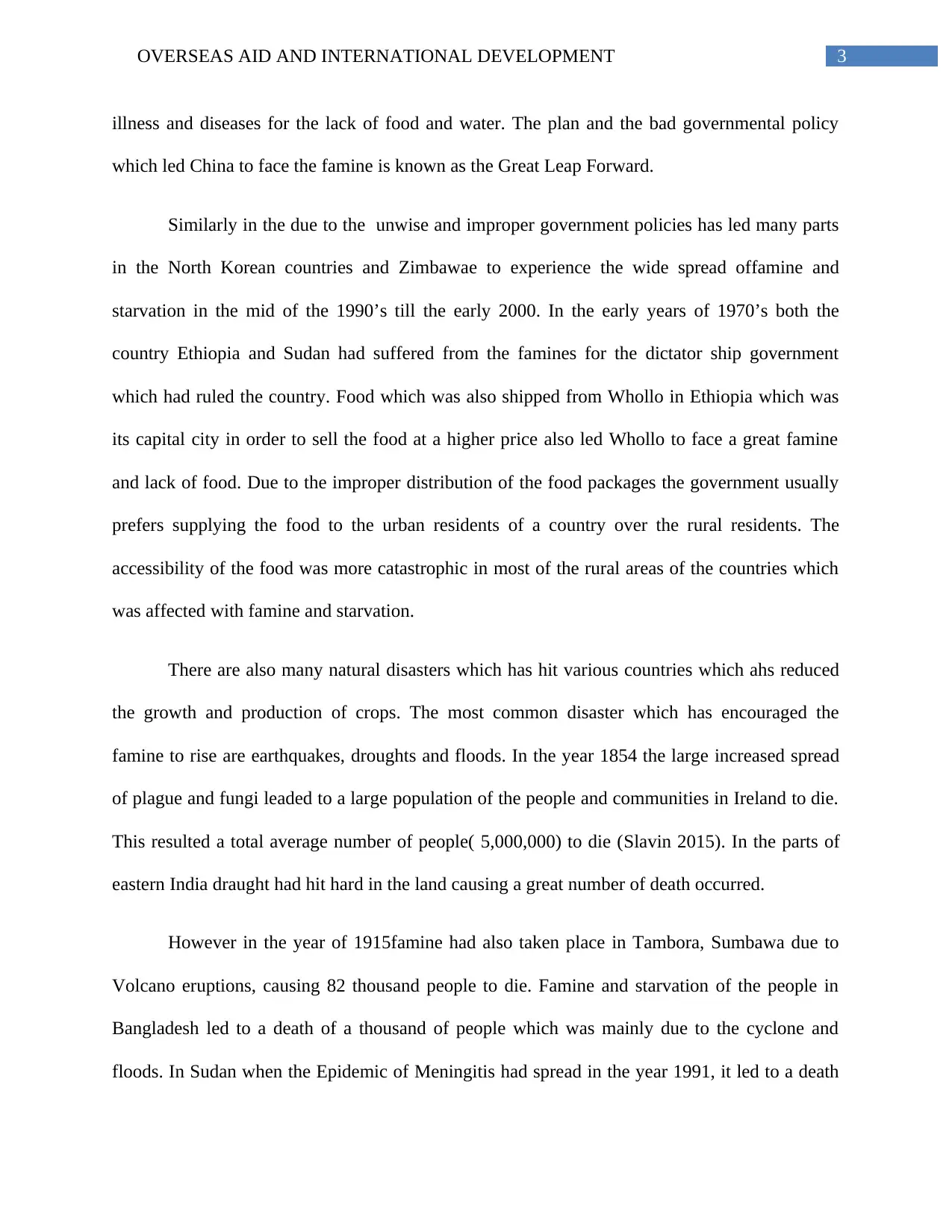
3OVERSEAS AID AND INTERNATIONAL DEVELOPMENT
illness and diseases for the lack of food and water. The plan and the bad governmental policy
which led China to face the famine is known as the Great Leap Forward.
Similarly in the due to the unwise and improper government policies has led many parts
in the North Korean countries and Zimbawae to experience the wide spread offamine and
starvation in the mid of the 1990’s till the early 2000. In the early years of 1970’s both the
country Ethiopia and Sudan had suffered from the famines for the dictator ship government
which had ruled the country. Food which was also shipped from Whollo in Ethiopia which was
its capital city in order to sell the food at a higher price also led Whollo to face a great famine
and lack of food. Due to the improper distribution of the food packages the government usually
prefers supplying the food to the urban residents of a country over the rural residents. The
accessibility of the food was more catastrophic in most of the rural areas of the countries which
was affected with famine and starvation.
There are also many natural disasters which has hit various countries which ahs reduced
the growth and production of crops. The most common disaster which has encouraged the
famine to rise are earthquakes, droughts and floods. In the year 1854 the large increased spread
of plague and fungi leaded to a large population of the people and communities in Ireland to die.
This resulted a total average number of people( 5,000,000) to die (Slavin 2015). In the parts of
eastern India draught had hit hard in the land causing a great number of death occurred.
However in the year of 1915famine had also taken place in Tambora, Sumbawa due to
Volcano eruptions, causing 82 thousand people to die. Famine and starvation of the people in
Bangladesh led to a death of a thousand of people which was mainly due to the cyclone and
floods. In Sudan when the Epidemic of Meningitis had spread in the year 1991, it led to a death
illness and diseases for the lack of food and water. The plan and the bad governmental policy
which led China to face the famine is known as the Great Leap Forward.
Similarly in the due to the unwise and improper government policies has led many parts
in the North Korean countries and Zimbawae to experience the wide spread offamine and
starvation in the mid of the 1990’s till the early 2000. In the early years of 1970’s both the
country Ethiopia and Sudan had suffered from the famines for the dictator ship government
which had ruled the country. Food which was also shipped from Whollo in Ethiopia which was
its capital city in order to sell the food at a higher price also led Whollo to face a great famine
and lack of food. Due to the improper distribution of the food packages the government usually
prefers supplying the food to the urban residents of a country over the rural residents. The
accessibility of the food was more catastrophic in most of the rural areas of the countries which
was affected with famine and starvation.
There are also many natural disasters which has hit various countries which ahs reduced
the growth and production of crops. The most common disaster which has encouraged the
famine to rise are earthquakes, droughts and floods. In the year 1854 the large increased spread
of plague and fungi leaded to a large population of the people and communities in Ireland to die.
This resulted a total average number of people( 5,000,000) to die (Slavin 2015). In the parts of
eastern India draught had hit hard in the land causing a great number of death occurred.
However in the year of 1915famine had also taken place in Tambora, Sumbawa due to
Volcano eruptions, causing 82 thousand people to die. Famine and starvation of the people in
Bangladesh led to a death of a thousand of people which was mainly due to the cyclone and
floods. In Sudan when the Epidemic of Meningitis had spread in the year 1991, it led to a death
Secure Best Marks with AI Grader
Need help grading? Try our AI Grader for instant feedback on your assignments.
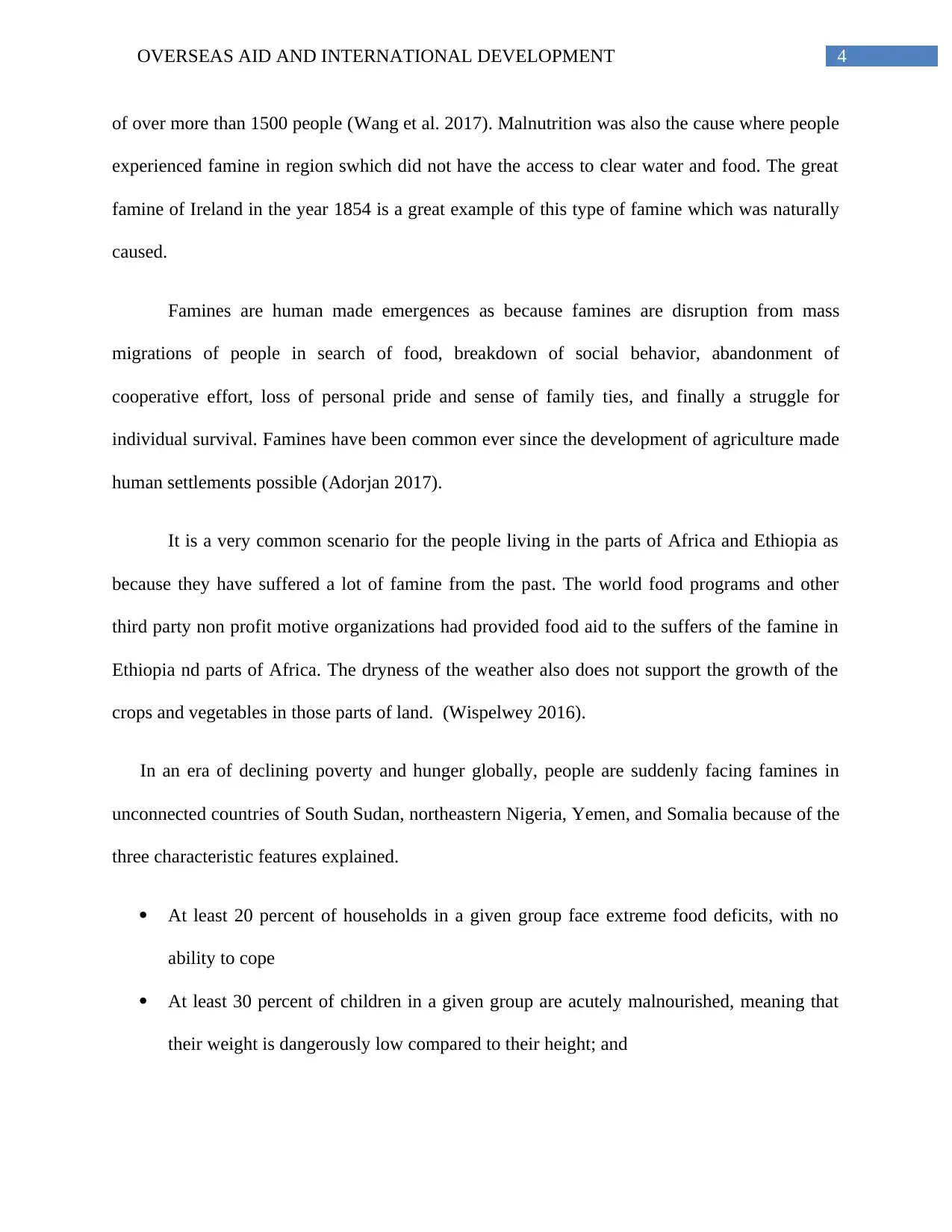
4OVERSEAS AID AND INTERNATIONAL DEVELOPMENT
of over more than 1500 people (Wang et al. 2017). Malnutrition was also the cause where people
experienced famine in region swhich did not have the access to clear water and food. The great
famine of Ireland in the year 1854 is a great example of this type of famine which was naturally
caused.
Famines are human made emergences as because famines are disruption from mass
migrations of people in search of food, breakdown of social behavior, abandonment of
cooperative effort, loss of personal pride and sense of family ties, and finally a struggle for
individual survival. Famines have been common ever since the development of agriculture made
human settlements possible (Adorjan 2017).
It is a very common scenario for the people living in the parts of Africa and Ethiopia as
because they have suffered a lot of famine from the past. The world food programs and other
third party non profit motive organizations had provided food aid to the suffers of the famine in
Ethiopia nd parts of Africa. The dryness of the weather also does not support the growth of the
crops and vegetables in those parts of land. (Wispelwey 2016).
In an era of declining poverty and hunger globally, people are suddenly facing famines in
unconnected countries of South Sudan, northeastern Nigeria, Yemen, and Somalia because of the
three characteristic features explained.
At least 20 percent of households in a given group face extreme food deficits, with no
ability to cope
At least 30 percent of children in a given group are acutely malnourished, meaning that
their weight is dangerously low compared to their height; and
of over more than 1500 people (Wang et al. 2017). Malnutrition was also the cause where people
experienced famine in region swhich did not have the access to clear water and food. The great
famine of Ireland in the year 1854 is a great example of this type of famine which was naturally
caused.
Famines are human made emergences as because famines are disruption from mass
migrations of people in search of food, breakdown of social behavior, abandonment of
cooperative effort, loss of personal pride and sense of family ties, and finally a struggle for
individual survival. Famines have been common ever since the development of agriculture made
human settlements possible (Adorjan 2017).
It is a very common scenario for the people living in the parts of Africa and Ethiopia as
because they have suffered a lot of famine from the past. The world food programs and other
third party non profit motive organizations had provided food aid to the suffers of the famine in
Ethiopia nd parts of Africa. The dryness of the weather also does not support the growth of the
crops and vegetables in those parts of land. (Wispelwey 2016).
In an era of declining poverty and hunger globally, people are suddenly facing famines in
unconnected countries of South Sudan, northeastern Nigeria, Yemen, and Somalia because of the
three characteristic features explained.
At least 20 percent of households in a given group face extreme food deficits, with no
ability to cope
At least 30 percent of children in a given group are acutely malnourished, meaning that
their weight is dangerously low compared to their height; and
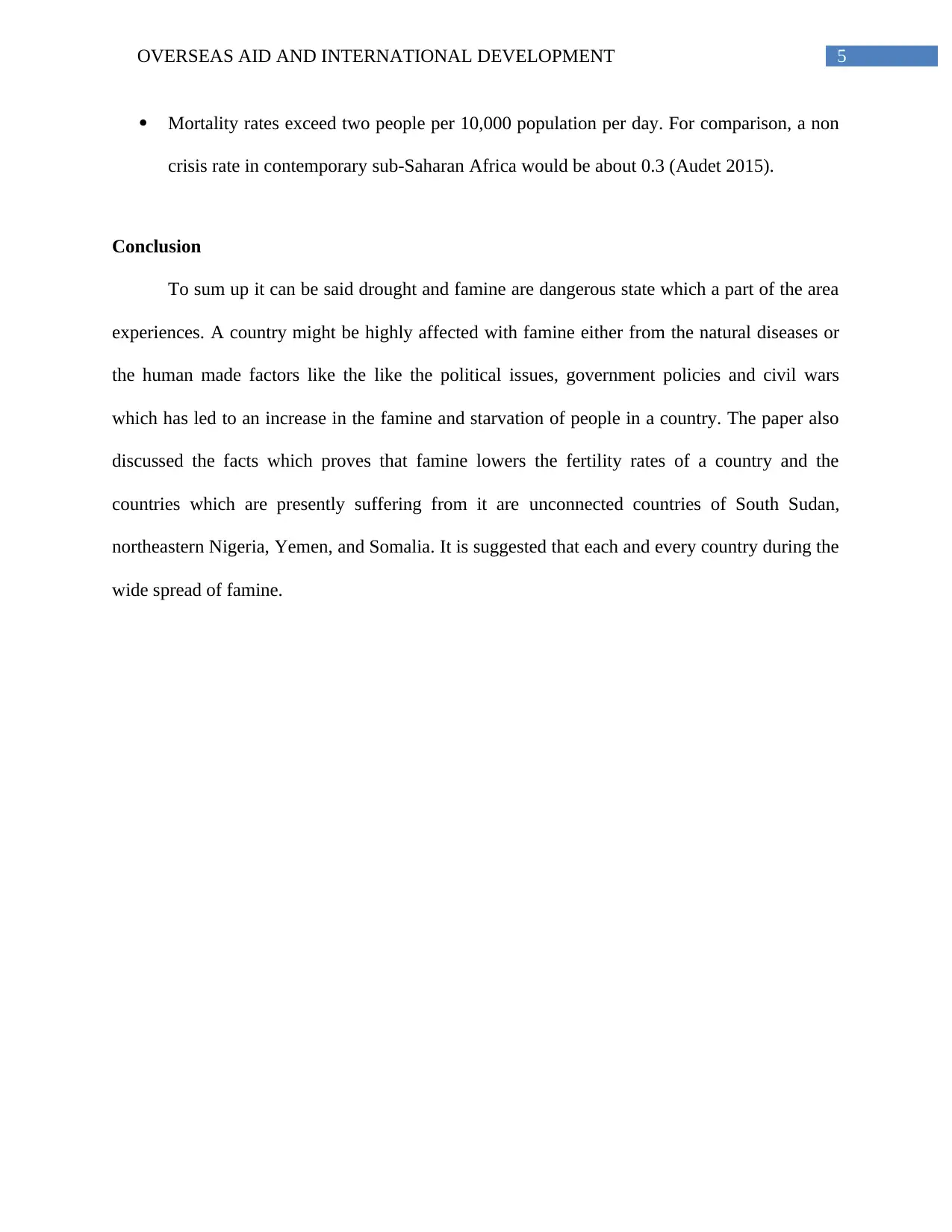
5OVERSEAS AID AND INTERNATIONAL DEVELOPMENT
Mortality rates exceed two people per 10,000 population per day. For comparison, a non
crisis rate in contemporary sub-Saharan Africa would be about 0.3 (Audet 2015).
Conclusion
To sum up it can be said drought and famine are dangerous state which a part of the area
experiences. A country might be highly affected with famine either from the natural diseases or
the human made factors like the like the political issues, government policies and civil wars
which has led to an increase in the famine and starvation of people in a country. The paper also
discussed the facts which proves that famine lowers the fertility rates of a country and the
countries which are presently suffering from it are unconnected countries of South Sudan,
northeastern Nigeria, Yemen, and Somalia. It is suggested that each and every country during the
wide spread of famine.
Mortality rates exceed two people per 10,000 population per day. For comparison, a non
crisis rate in contemporary sub-Saharan Africa would be about 0.3 (Audet 2015).
Conclusion
To sum up it can be said drought and famine are dangerous state which a part of the area
experiences. A country might be highly affected with famine either from the natural diseases or
the human made factors like the like the political issues, government policies and civil wars
which has led to an increase in the famine and starvation of people in a country. The paper also
discussed the facts which proves that famine lowers the fertility rates of a country and the
countries which are presently suffering from it are unconnected countries of South Sudan,
northeastern Nigeria, Yemen, and Somalia. It is suggested that each and every country during the
wide spread of famine.
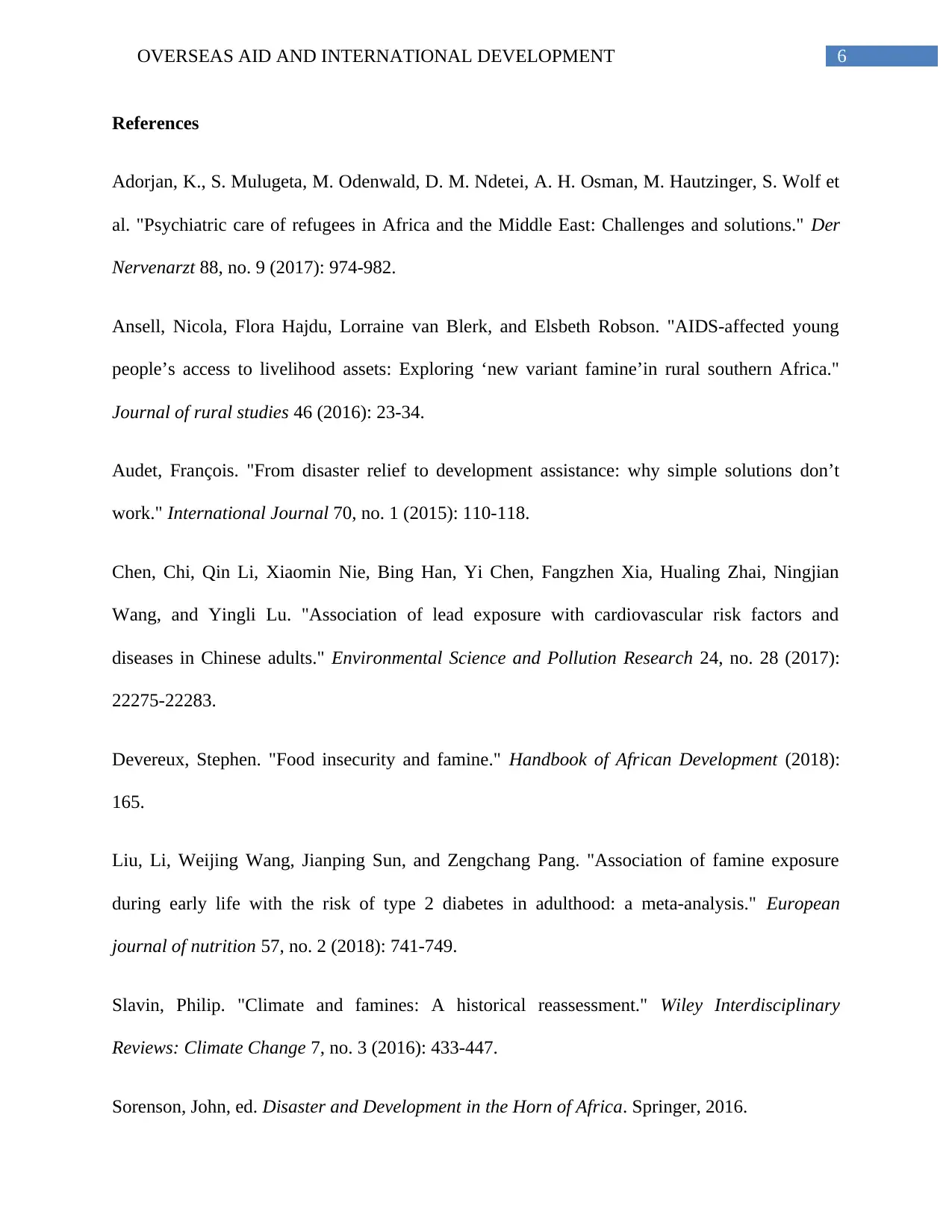
6OVERSEAS AID AND INTERNATIONAL DEVELOPMENT
References
Adorjan, K., S. Mulugeta, M. Odenwald, D. M. Ndetei, A. H. Osman, M. Hautzinger, S. Wolf et
al. "Psychiatric care of refugees in Africa and the Middle East: Challenges and solutions." Der
Nervenarzt 88, no. 9 (2017): 974-982.
Ansell, Nicola, Flora Hajdu, Lorraine van Blerk, and Elsbeth Robson. "AIDS-affected young
people’s access to livelihood assets: Exploring ‘new variant famine’in rural southern Africa."
Journal of rural studies 46 (2016): 23-34.
Audet, François. "From disaster relief to development assistance: why simple solutions don’t
work." International Journal 70, no. 1 (2015): 110-118.
Chen, Chi, Qin Li, Xiaomin Nie, Bing Han, Yi Chen, Fangzhen Xia, Hualing Zhai, Ningjian
Wang, and Yingli Lu. "Association of lead exposure with cardiovascular risk factors and
diseases in Chinese adults." Environmental Science and Pollution Research 24, no. 28 (2017):
22275-22283.
Devereux, Stephen. "Food insecurity and famine." Handbook of African Development (2018):
165.
Liu, Li, Weijing Wang, Jianping Sun, and Zengchang Pang. "Association of famine exposure
during early life with the risk of type 2 diabetes in adulthood: a meta-analysis." European
journal of nutrition 57, no. 2 (2018): 741-749.
Slavin, Philip. "Climate and famines: A historical reassessment." Wiley Interdisciplinary
Reviews: Climate Change 7, no. 3 (2016): 433-447.
Sorenson, John, ed. Disaster and Development in the Horn of Africa. Springer, 2016.
References
Adorjan, K., S. Mulugeta, M. Odenwald, D. M. Ndetei, A. H. Osman, M. Hautzinger, S. Wolf et
al. "Psychiatric care of refugees in Africa and the Middle East: Challenges and solutions." Der
Nervenarzt 88, no. 9 (2017): 974-982.
Ansell, Nicola, Flora Hajdu, Lorraine van Blerk, and Elsbeth Robson. "AIDS-affected young
people’s access to livelihood assets: Exploring ‘new variant famine’in rural southern Africa."
Journal of rural studies 46 (2016): 23-34.
Audet, François. "From disaster relief to development assistance: why simple solutions don’t
work." International Journal 70, no. 1 (2015): 110-118.
Chen, Chi, Qin Li, Xiaomin Nie, Bing Han, Yi Chen, Fangzhen Xia, Hualing Zhai, Ningjian
Wang, and Yingli Lu. "Association of lead exposure with cardiovascular risk factors and
diseases in Chinese adults." Environmental Science and Pollution Research 24, no. 28 (2017):
22275-22283.
Devereux, Stephen. "Food insecurity and famine." Handbook of African Development (2018):
165.
Liu, Li, Weijing Wang, Jianping Sun, and Zengchang Pang. "Association of famine exposure
during early life with the risk of type 2 diabetes in adulthood: a meta-analysis." European
journal of nutrition 57, no. 2 (2018): 741-749.
Slavin, Philip. "Climate and famines: A historical reassessment." Wiley Interdisciplinary
Reviews: Climate Change 7, no. 3 (2016): 433-447.
Sorenson, John, ed. Disaster and Development in the Horn of Africa. Springer, 2016.
Paraphrase This Document
Need a fresh take? Get an instant paraphrase of this document with our AI Paraphraser
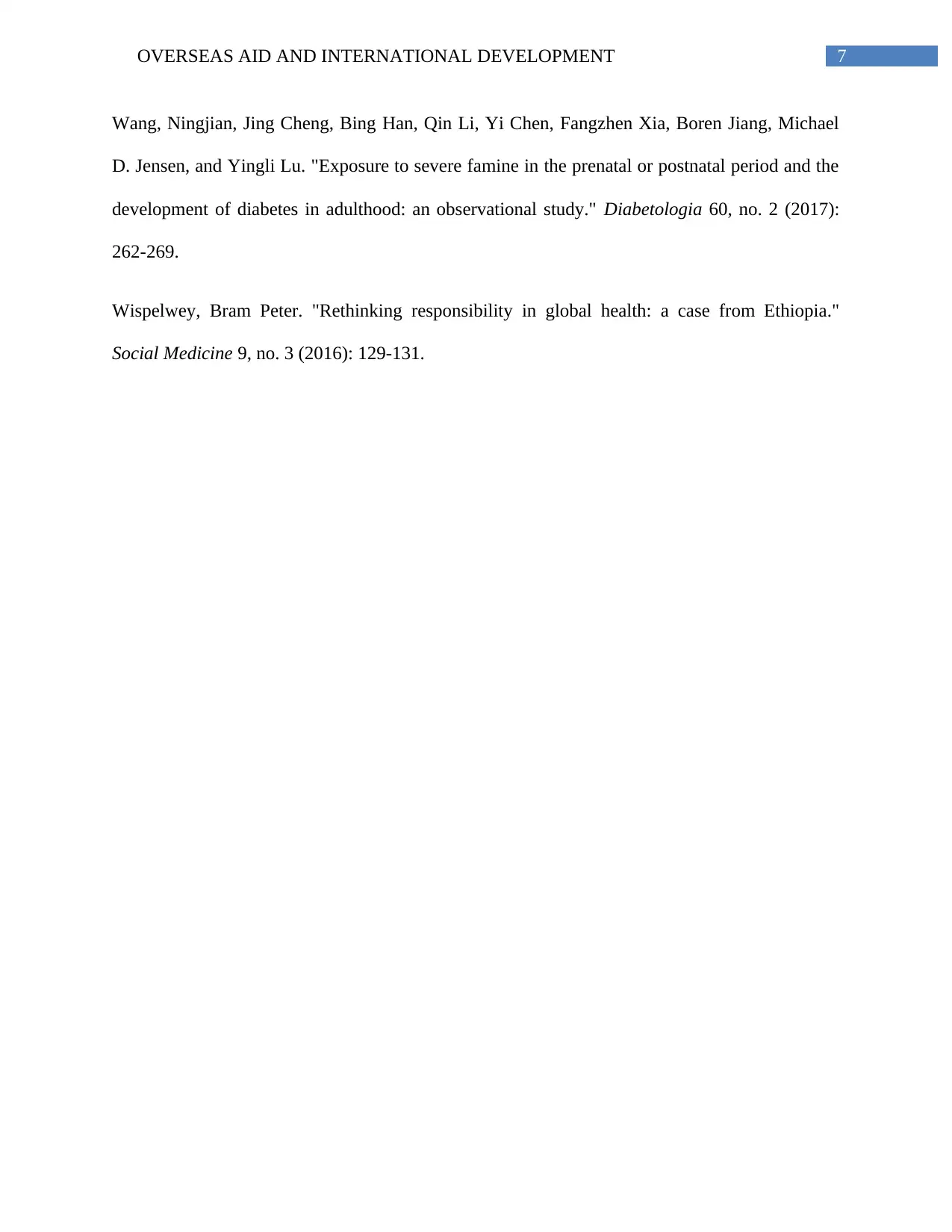
7OVERSEAS AID AND INTERNATIONAL DEVELOPMENT
Wang, Ningjian, Jing Cheng, Bing Han, Qin Li, Yi Chen, Fangzhen Xia, Boren Jiang, Michael
D. Jensen, and Yingli Lu. "Exposure to severe famine in the prenatal or postnatal period and the
development of diabetes in adulthood: an observational study." Diabetologia 60, no. 2 (2017):
262-269.
Wispelwey, Bram Peter. "Rethinking responsibility in global health: a case from Ethiopia."
Social Medicine 9, no. 3 (2016): 129-131.
Wang, Ningjian, Jing Cheng, Bing Han, Qin Li, Yi Chen, Fangzhen Xia, Boren Jiang, Michael
D. Jensen, and Yingli Lu. "Exposure to severe famine in the prenatal or postnatal period and the
development of diabetes in adulthood: an observational study." Diabetologia 60, no. 2 (2017):
262-269.
Wispelwey, Bram Peter. "Rethinking responsibility in global health: a case from Ethiopia."
Social Medicine 9, no. 3 (2016): 129-131.
1 out of 8
Related Documents
Your All-in-One AI-Powered Toolkit for Academic Success.
+13062052269
info@desklib.com
Available 24*7 on WhatsApp / Email
![[object Object]](/_next/static/media/star-bottom.7253800d.svg)
Unlock your academic potential
© 2024 | Zucol Services PVT LTD | All rights reserved.





